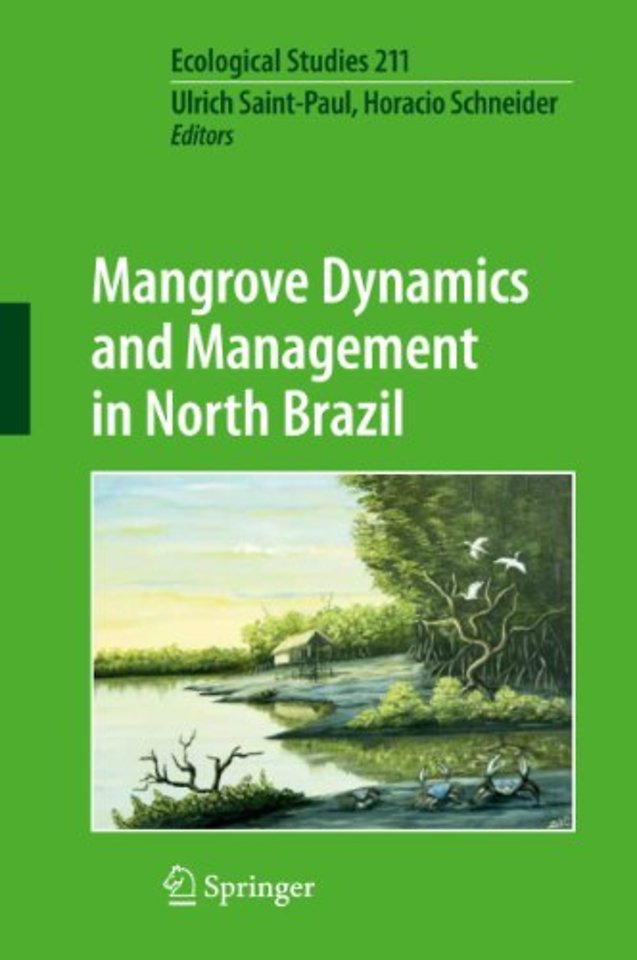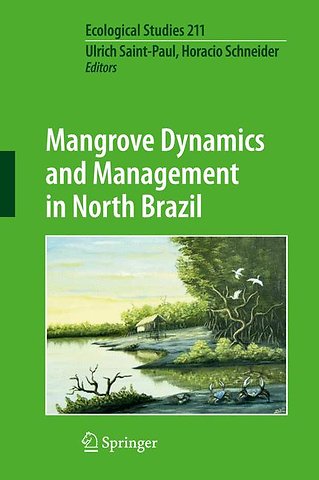Mangrove Dynamics and Management in North Brazil
Samenvatting
Mangrove ecosystems are being increasingly threatened by human activities. Their biotic productivity supplies food and other resources to the human populations that inhabit or make use of them. This volume highlights the results of a ten-year German / Brazilian research project, called MADAM, in one of the largest continuous mangrove areas of the world, located in northern Brazil. Based on the analysis of the ecosystem dynamics, management strategies for the conservation and sustainable use of mangroves are presented and discussed. Beyond the scientific results, this book also provides guidelines for the development of international cooperation projects.
Specificaties
Inhoudsopgave
1. The Need for a Holistic Approach in Mangrove Research and Management
U. Saint-Paul and H. Schneider
2. MADAM, Concept and Reality
U. Saint-Paul
PART II: Geography and Biogeochemistry
3. Geography of the Bragança Region
G. Krause
3.1. Background and Scope
3.2. Spatial Boundaries
3.3. Principal Features of the Natural and Social System
3.4. Co-Evolutionary Outcomes of the Natural and Social Dynamics
References
4. Palaeoenvironmental Reconstruction
H. Behling, M. Cohen, R.J. Lara, and V. Vedel
4.1. Coastal Region of Northern Brazil
4.2. Holocene Environmental Changes
4.3. Model of Bragança Mangrove Development
4.4. Holocene Coastal Dynamics
References
5. The Biogeochemistry of the Caeté Mangrove-Shelf System
B. Koch, T. Dittmar, and R.J. Lara
5.1. Introduction and Overview
5.2. Sediment Processes
5.3. The Outwelling of Detritus and Decomposition Products into Coastal Waters
5.4. The Fate of Mangrove-Outwelling on the Continental Shelf
5.5. Concluding Remarks
References
PART III: Floristic and Faunistic Studies in Mangroves
6. Mangrove Vegetation of the Caeté Estuary
U. Mehlig, M.P.M. Menezes, A. Reise, and E. Medina
6.1. Floristics and Forest Structure
6.2. Litterfall and Phenology
6.3. Dendrochronological Studies of Rhizophora mangle Tree
6.4. Soil-Vegetation Nutrient Relations
6.5. Concluding Remarks and Outlook
References
7. Mangrove Infauna and Sessile Epifauna
C.R. Beasley, M.E.B. Fernandes, E.A.G. Figueira, D.S. Sampaio, K.R. Melo, and R.S. Barros
7.1. Introduction
7.2. The Infauna of the Mangrove Forest at the Furo Grande Tidal Creek
7.3. Comparison of the Benthic Fauna among Sites with Differing Degrees of Degradation
7.4. Settlement of the Tidal Creek Epifauna in the Caeté Mangrove Estuary
7.5. Differences in Settlement of Epibenthos between Mangrove and Tidal Creek Habitats
7.6. Conclusions
References
PART IV: Dynamics in the Mangrove System
8. Drivers of Temporal Changes in Mangrove VegetationBoundaries and Consequences for Land Use
R.J. Lara, M. Cohen, and C. Szlafsztein
8.1. Introduction
8.2. Influence of Inundation Frequency and Sediment Salinity on Wetland Structure
8.3. Changes in Current Vegetation Units: Boundaries, Ecotone Shifts and Consequences for Land Use
References
9. System Processes and Forest Development
U. Berger and M. Wolff
9.1. The Interlink between the Modelling Approaches
9.2. Trophic Pathways
9.3. Forest Dynamics under Different Natural Disturbance Regimes
9.4. Conclusions
References
10. Synoptic Analyses of Mangroves for Coastal Zone Management
G. Krause and M. Bock
10.1. Background and Scope
10.2. Research strategy
10.3. Change Dynamics
10.4. Classification of Mangrove Patterns
10.5. Potential Contributions to Coastal Zone Management
References
PART V: Ecology and Fishery of Fin-Fish in the Mangrove System
11. Distribution Pattern of Fish in a Mangrove Estuary
M. Barletta and U. Saint-Paul
11.1. Seasonal Changes in the Caeté Estuary
11.2. Fish Assemblage Patterns
References
12. Dynamics in Mangrove Fish Assemblages on a Macrotidal Coast
U. Krumme and U. Saint-Paul
12.1. Introduction
12.2. Environmental Setting
12.3. Nekton Sampling in Macrotidal Environments
12.4. Trends in Species Richness, Biomass and Density along a Shoreline Gradient
12.5. Composition of Transients
12.6. Tidal Movements
12.7. Tidal and Diel Changes in The Intertidal Fish Assemblages
12.8. Tide-to-Tide, Weekly, Fortnightly and Monthly Variation in Abundance, Catch Weight and Species Richness of Transients
12.9. Patterns in Feeding
12.10. Spatial Patterns in the Intertidal Fish Fauna
12.11. Implications for Future Research and Long-Term Monitoring
References
13. An Evaluation of the Larval Fish Assemblage
A. Barletta-Bergan
13.1. Value of Mangroves and Estuaries as Nurseries
13.2. First Ichthyoplankton Survey
13.3. A North Brazilian Larval Fish Community in Relation to Mangroves Worldwide
References
14. Molecular Phylogenetic and
Net verschenen
Rubrieken
- aanbestedingsrecht
- aansprakelijkheids- en verzekeringsrecht
- accountancy
- algemeen juridisch
- arbeidsrecht
- bank- en effectenrecht
- bestuursrecht
- bouwrecht
- burgerlijk recht en procesrecht
- europees-internationaal recht
- fiscaal recht
- gezondheidsrecht
- insolventierecht
- intellectuele eigendom en ict-recht
- management
- mens en maatschappij
- milieu- en omgevingsrecht
- notarieel recht
- ondernemingsrecht
- pensioenrecht
- personen- en familierecht
- sociale zekerheidsrecht
- staatsrecht
- strafrecht en criminologie
- vastgoed- en huurrecht
- vreemdelingenrecht

